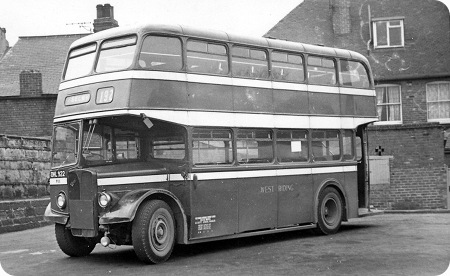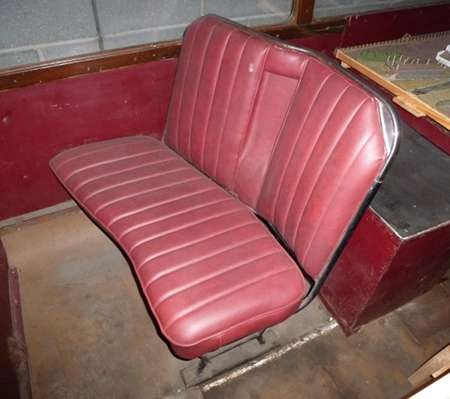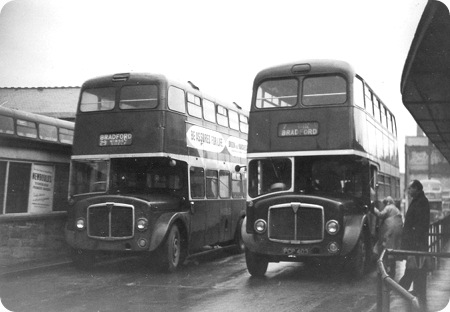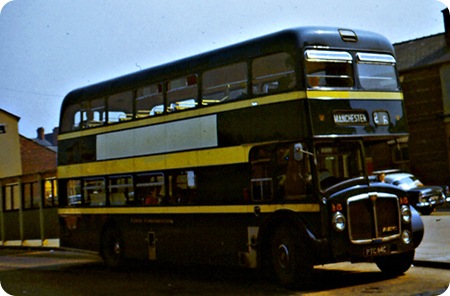
Copyright Unknown
West Riding Automobile
1951
AEC Regent III
Roe L50R
Another bus from the large West Yorkshire independent this time an AEC Regent III. West Riding did not favour any particular make of vehicle they had various models from each of AEC, Leyland, Daimler and Guy. How much nicer this bus would of looked with a shiny radiator instead of a painted one.
I don’t know who the photographer was but the location is Pontefract Bus Station. The bus is on the 192 service to Selby, which ran every two hours and which I caught home from school. The route was taken over from Bullock’s (B&S Motor Service) in 1950.
Del
Although the date of acquisition is 1951, the painted radiator may be a hangover from the Bullock and Sons takeover in 1950, as all their vehicles had painted radiators. West Riding also generally kept the buses acquired from B&S on the former B&S routes.
An interesting feature about this vehicle was the passenger seat design. The double seats, at least in the lower saloon, had a kind of staggered design to allow easy access to the window seat.
TC
The bus is most likely to have been allocated to the former B & S depot at Chimes Road, Selby which was demolished in the late 1990s and replaced with the present new one near the railway station. I did a fair amount of work out of both premises until retiring (from Pontefract depot) in May 2001 – I did many a trip on the modern version of this route and, although the Selby fleet was interesting and well maintained, never with a vehicle as delightful as the one shown.
Chris Youhill
09/06/11 – 08:43
This bus is not ex B&S the fleet number is too high it is one of batch of 10 and was allocated to Featherstone depot, at the time of this photo. as to the radiator if you look at photo’s of ex B&S AEC Regents they have chrome radiators ahl 927 fleet number 295 is a good example of this (can be seen in David W Allen’s book West Riding 2 page 71
Stan
28/10/11 – 16:20
Further to my last comment this bus was new to West Riding, in 1952, a full two years after they bought B&S so impossible to be ex B&S
Stan
28/10/11 – 16:26
I quite agree Stan, BBF 9 as the ex B&S Regents as BHL 641-3 and BHL 926 – 319-22 built in 1948
Peter
09/12/12 – 07:56
An excellent book called West Riding 1 in the Super Prestige range by David W Allen has nearly all West Riding bus and coach photographs in including several A.E.C centre entrance double deckers in both red and green livery. I worked at Belle Isle depot as an apprentice from 1956 and often travelled into the City centre on one of these fine machines. The pre select gearbox made them quick off the mark and ideal for city work because of the twin staircase and wide entrance.
Barrie Micklethwaite
09/12/12 – 11:43
Barrie – your last observation is so very true even though it applies to a totally different era, but quick loading was as important then as it OUGHT to be now. The Industry has completely lost the plot nowadays, admittedly partly "pushed" by such things as buggy accessibility etc. Towards the end of my career as a driver, and still as a passenger, I despair at the impossibility of present designs with a single doorway and the buggy/wheelchair bay right opposite the bottom of the staircase. Add to this the "double standard" operator publicity to "remain seated until the vehicle stops" by managements who know full well that if all passengers did so, in both saloons, the peak period buses would still be out after Midnight.
I must make clear that I am all in favour of good and sympathetic service for the passengers (and these modern "customers" whoever they are !!) but there are only sixty minutes in the hour. I have a wide experience of trying to keep time with single doorway buses and, due to resolutely refusing ever to drive badly, I was frequently late on busy journeys and man enough to shoulder all the resultant sneering and abuse from all quarters. Knowing full well that I could put up a good verbal defence on this issue the Management were never brave enough to tackle me about it and, had they done so, they would have been shot down in factual and statistical flames !!
Just in conclusion, notice how multiple doorways in London and on the Continent keep the bus moving, and all the much hyped nonsense about serious passenger accidents are wildly exaggerated – that’s not to deny that extra diligence from drivers is essential on such vehicles.
Chris Youhill
05/10/14 – 11:07
With reference to the AEC double decker, I used conduct on the Selby route when I started there in 1962 ,it started at Halfpenny Lane Pontefract on the odd hour went via Pontefract bus station to Selby, but the other buses Leyland PD1 and 2s and old Guys and Guy Arabs used to operate on the 192 Selby run.
Les Cranswick
06/10/14 – 16:45

TC – Noting your comment on the ‘staggered’ double seat design, I wonder whether this was in fact another example of the Sidil Morsat experimental seat of the period.
John Darwent




